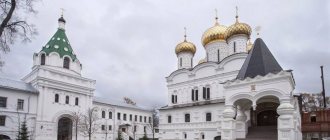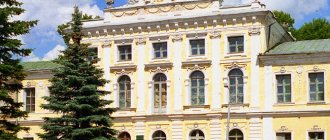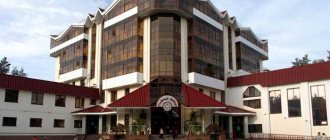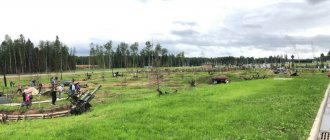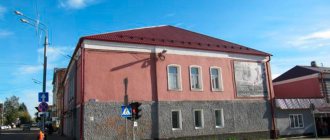The Volgograd region is part of the Southern Federal District of Russia. Its center is the hero city of Volgograd. The history of the region as an independent entity began in 1919, and its modern center was still called Tsaritsyn. After a series of transformations and divisions of territories between neighboring regions, in 1961 the Volgograd region acquired its current name and territory.
On the territory of the Volgograd region two large rivers flow - the Don and the Volga, which are connected by the Volga-Don Canal; in these places there are steppe and forest-steppe zones, semi-deserts and deserts are found. The diverse landscapes and natural areas of the region provide shelter for many representatives of the fauna - rodents, hares, saigas, predators, foxes, even jungle cats and wolves, wild boars, moose, hedgehogs, birds of prey, cranes, bustards, etc.
In the Volgograd region, 7 beautiful nature conservation parks, several hunting reserves have been created, many objects are classified as natural monuments. In these places, many historical and cultural monuments of various eras, architectural masterpieces of religious significance, and unique geological objects have been preserved.
Volga-Akhtuba floodplain
The Volga-Akhtubinskaya floodplain is one of the most popular and beautiful environmental parks in the Volgograd region. It begins immediately behind the Volzhskaya hydroelectric power station, in the place where Akhtuba is separated from the Volga and many channels, oxbow lakes, eriks, lakes, ponds and small rivers are formed, surrounded for almost 450 km by endless steppes. These beautiful places attract, first of all, avid fishermen from all over Russia.
Numerous creeks and lakes overgrown with reeds serve as feeding and resting grounds for migratory birds, many of which are classified as endangered species. Also, thanks to good water supply, the Volga-Akhtuba floodplain is rich in green floodplain oak forests, beautiful water meadows with lush herbs.
In terms of the number of sunny and clear days, these places in the Volgograd region are not inferior to the subtropics of Crimea, so it is here that a beautiful natural object, unique for these latitudes, is located - the lotus lake. The lake itself is small and from August to September it is completely covered with green leaves, in the heart of which these beautiful and sacred flowers for many religions bloom.
Architectural structures in Volgograd
Interesting places in Volgograd are located not only in that part of the city where sculptures and monuments dedicated to the Second World War are concentrated. Guests of the city will also find it informative to visit the following architectural monuments.
Tsaritsyn fire department
This is the first fire brigade building that was built on the territory of Volgograd. The building was put into operation in 1897. It is a picturesque architectural ensemble made in the eclectic style.
The building is divided into a barracks part, where the firefighters were on guard, and an observation bath, the height of which is 40 m (equal to 3 modern 4-story buildings). Today it is a monument of history and architecture, which you can see completely free of charge. Located on the street. Deep ravine.
Don't miss the most popular article in the section: Metro Nizhny Novgorod. Diagram, map, description.
Beit David
On the street Balakhinskaya, 2 is the largest synagogue in the Volga region. It was built by the Jewish community of Tsaritsyn (the old name of Volgograd) in 1888. At that time, at least 800 religious Jews lived in the city. During the Soviet era, the prayer house was closed under pressure from the central government.
The city clinic was located here, and since 2001 the building was returned to the Jewish community. The building was decorated by the famous Israeli architect and specialist in synagogue design, Aaron Ostreicher. Currently, it is a functioning synagogue, where services are held regularly. There is no fee to visit this architectural landmark.
House of Trade Unions
This is a cultural institution and architectural heritage site, which is located on Avenue. Lenin. It was built in 1957 to house trade unions of the city's industrial enterprises. The façade of the building is decorated with decorative stucco and majestic colonnades.
Externally, the building resembles a palace complex, and the overall architectural ensemble is atypical for the late Stalin era. Visiting the site is free. The institution is open from 08:00 to 17:00. Saturday and Sunday are days off. Because of its round shape, the indigenous residents of Volgograd call this building the “big toilet.”
Salt Lake Elton
Lake Elton is one of the most interesting and beautiful natural places in the Volgograd region. This is the largest salt lake in Europe, covering an area of 152 km2 of the Volga steppe. The original beauty of the lake is in its color - the salt crystals covering its shores in a wide strip give the water bowl a golden-pink hue.
The coast of the lake is beautiful and varied - shallow waters covered with salt crystals, picturesque beaches and deltas of flowing rivers, green valleys and ravines. Several bitterly salty rivers and fresh springs flow into the lake, and the hot sun evaporates the water, leaving only brine. In addition to the usual brine, it also contains other types of bitter salts - Elton is the richest salt lake in the world. The thickness of its salt layers has not yet been determined precisely; it has only been established that the depth of their occurrence becomes thicker as they move away from the coast.
The healing properties of the salty and hydrogen sulfide mud of the beautiful Lake Elton have been used for decades to treat the musculoskeletal system and nervous system. The brine and silt mineral mud of this place is not inferior in its properties to the mud of the Dead Sea.
Where to eat in Volgograd
There are many cozy cafes and restaurants in Volgograd, where the food is tasty, satisfying and at a low cost.
The following establishments are recommended for visiting:
- Voronka coffee shop – located on the street. Komsomolskaya, 10, there is exclusively European cuisine, suitable for vegetarians, the average bill is 300 rubles;
- the restaurant Shchastye Is - an establishment of French cuisine with an average cost of dishes from 250 to 800 rubles, located at the address: Alleya Heroev, 2;
- Restaurant Gifts of Armenia is an establishment of Caucasian cuisine, which is located on the street. Parkhomenko, 15a, the average cost of lunch here is 500-600 rubles;
- Chocolaterie Brownie Store - a pastry cafe that sells sweets made with chocolate and also brews delicious coffee, average prices are 700-900 rubles, located on the street. Chuikova, 21;
- cafe Marusya – located at the address: Alley of Heroes, 2, here visitors can try European and Russian cuisine, many fish dishes, the average bill is 700-1000 rubles.
Most city guests who dined in Volgograd restaurants and cafes noted that the most delicious dishes are those made from fish. The leader of consumer preferences is fish soup, as well as sterlet with cheese.
Alexandrovsky graben
The Alexandrovsky graben is one of the unique geological places in the Volgograd region. A graben is a section of the earth's crust that has descended along tectonic faults in relation to its neighbors. Most often they are found in mountainous countries, so the size of the Alexander Graben is relatively small - only a few kilometers by a few meters in width, but the “depth” of its failure is about 200 m, and at its bottom there is a small beautiful lake.
The study of the Alexander Graben allows scientists to decipher the history of geographical events of these places - formations and relics of the Ice Age, silty lake sediments during the hot climate of the Neogene, evidence of the existence of a coastal marine zone here.
Interesting places to relax with children
When traveling around Volgograd with children, you can have a pleasant time with the whole family by visiting the following interesting places in the city.
Mobius strip maze
This is an entertainment complex that includes a labyrinth assembled from a large number of ribbons. They create the illusion of infinity and make it difficult to navigate the winding tunnels of the labyrinth.
Located near Mamayev Kurgan on the street. Zemlyachki, 110B. Recommended for visiting by children aged 5 to 12 years. The ticket price is 150 rubles.
Oceanarium
The Volgograd Oceanarium is a place of simultaneous discovery and entertainment. It will be interesting here for both children and their parents. Visitors to the aquarium have the opportunity to see crocodiles, penguins, sea turtles and other inhabitants of the deep waters. The entertainment center is located on the street. Zemlyachki, 110, B. The cost of the entrance ticket is 200 rubles.
Trampoline center Gravity
This is a complex of large and durable trampolines that allow children and parents to forget about gravity and soar in the air with minimal physical exertion. Located at: st. Kozlovskaya, 42. You will have to pay 300 rubles for visiting the Trampoline Center. per person.
Park-Museum of Russian Fairy Tales named after A.S. Pushkin
In the village of Kirovets, Volgograd region, there is a unique and beautiful Museum of Russian Fairy Tales named after. A.S. Pushkin. The museum's exhibition includes many mannequins and decorations based on everyone's favorite fairy tales - Baba Yaga, Koschey the Immortal, Mermaid on the Oak Branches from Lukomorye, Nightingale the Robber, Emelya the Fool, Little Humpbacked Horse, Leshy, etc.
The museum was created on the initiative of a local married couple, the Pavlovs, and during the work they were joined by their neighbors who took part in leading excursions. Currently, the museum is in the process of expansion; it is planned to create the head of the knight from “Ruslan and Lyudmila”, a 10-meter whale and other exhibits.
Route for exploring Volgograd on your own for 1-2 days
When traveling around Volgograd on your own, staying here for 1-2 days, it is recommended to visit the following historical sites and natural attractions:
- monument to the Motherland Calling;
- Mamaev kurgan;
- Museum-panorama of the Battle of Stalingrad"
- reserve "Old Sarepta".
The best way to complete your acquaintance with the history of the city is to take a walk along the Central Embankment, where you can admire the beauty of the Volga, the red evening sunset, and plunge into the romantic atmosphere.
Kamyshinsky Museum of Local Lore
One of the most famous museums in the Volgograd region is the Kamyshinsky Museum of Local Lore, founded in 1961. Just 6 years later this place became a branch of the Volgograd Museum of Local Lore. Currently, the museum's exhibitions occupy 14 halls, telling about the flora and fauna of the region, climate, archeology and ethnic characteristics. Of particular interest is the rare collection of fossils; some specimens have no analogues in the world.
Not only the exhibits are interesting in the museum, but also the beautiful building in which it is located. This building was built in 1901 - a former Zemstvo house, built for representatives of the local government. The mansion was built in the Russian Baroque style with the inclusion of elements of folk architecture and has the status of an architectural monument of federal significance.
Hotels in Volgograd
While in Volgograd on a business trip or traveling around the city as a tourist, you can stay in the following hotels:
- Volgograd Hilton - price for accommodation here is 3,600 rubles. per day, the price includes breakfast, free internet, parking (located on Profsoyuznaya str., 13);
- Stalingrad - the hotel is located on the street. Rokosovsky, 102, cost of living here is 2450 rubles. per day, you can order breakfast, for which you will have to pay 380 rubles, there is free internet;
- Mini-hotel Sonberry is a budget option that will cost 1,500 rubles. per day, located on the street. Dymchenko, 8, rooms are equipped with all amenities, meals are not included in the price;
- The Sosnovy Bor estate is a cottage complex, accommodation in which costs 7,000 rubles. per day, the hotel is located on the street. Angarskaya, 137/181;
- Plaza – a hotel with comfortable rooms, which is located on the street. Novouzenskaya, 2/1, the price of living here is 1,700 rubles. per person.
While in Volgograd, you can choose a hotel for any budget, from economy class to expensive apartments or an individual cottage, such as the Sosnovy Bor Estate.
Ust-Medveditsky Spaso-Preobrazhensky Monastery
One of the most visited and revered places by believers in the Volgograd region is the beautiful Ust-Medveditsky Spaso-Preobrazhensky convent, founded in these places around 1652. 100 years after its construction, on the eve of Easter 1752, the monastery building completely slid into the waters of the flood Don and collapsed, it was rebuilt only in 1759. The flourishing of the monastery’s activity is associated with the name of Mother Arsenia, who became the abbess of the monastery in 1863.
After the October Revolution and during the Second World War, more than 50 buildings of the monastery were destroyed and devastated. The surviving buildings housed a correctional colony, and the only church housed a power plant, which was dismantled by explosion in the late 60s. It was only in 1991 that a decision was made to restore this important place for believers.
Behind the beautiful snow-white restored walls of the monastery and in its surroundings there are many attractions that attract guests here in addition to religious needs, for example, underground tunnels dug in 1874 with a total length of 150 m. In one of the caves there is a healing “Nun’s Stone” - the main shrine of the monastery , keeping the trace of the knees and palms of the Mother of God, who, according to legend, appeared to Mother Arsenia.
Monuments in Volgograd
Interesting places in Volgograd are represented by a large number of monuments that have become real works of art, or are active reminders of the tragic pages of the city’s history.
The Motherland is calling
This is a huge sculpture of the image of a Russian woman who holds a raised sword in her hand and calls on her children, citizens of the country, to fight against the enemy. The height of the sculpture is 85 m. Construction of the monument took place from 1959 to 1967.
The monument is made of high quality reinforced concrete. The sculpture is dedicated to the events of the Battle of Stalingrad and glorifies the Soviet soldiers who fought against the aggressor. Visiting this cultural site is free, and the monument is located on Mamayev Kurgan.
Gerhardt's Mill
This is a dilapidated building that was damaged during World War II and was preserved in this form specifically to tell residents and guests of the city about the terrible consequences of hostilities. The monument is located on the street. Soviet.
The building was reconstructed to eliminate the threat of collapse. Today, this war monument can be visited completely free of charge at any time of the day. Before the outbreak of hostilities in the 40s, it was a steam mill that belonged to a Volga German, a merchant and trader named Alexander Gerhardt.
Museum panorama "Battle of Stalingrad"
A large memorial complex, including standard exhibition exhibits, as well as recreations of individual military actions using panoramas. It has the status of a historical reserve, which is visited annually by at least 2 million tourists coming from near and far abroad. All exhibition objects are dedicated to the Great Patriotic War and the Battle of Stalingrad itself.
The “Battle of Stalingrad” panorama will be an interesting place for lovers of the history of the Second World War in Volgograd
Here you can see everything from the equipment and weapons of a Red Army soldier to the living conditions of civilians surviving in the city during the period of hostilities. The memorial complex is located on the street. Marshala Chuikova, 47. Opening hours from 08-00 to 17-00 from Monday to Friday.
How to get around Volgograd
You can move around the city using the following types of public transport, which start running from 06:00 a.m. to 11:00 p.m.:
- trolleybus (cost 15 rubles);
- high-speed tram, 6 stations of which are underground (ticket price 12 rubles);
- buses (fare costs 25 rubles).
Visiting interesting places in Volgograd can be organized using a taxi, the average cost of which is from 300 to 700 rubles. depending on the distance of the trip.
Volgograd is a city with a rich and dramatic history, having studied which it is impossible to remain indifferent. Most people who have visited here as tourists fondly remember the city, the responsiveness of its inhabitants and the beauty of the Volga region.
Article design: Mila Friedan
Job
There are quite a lot of vacancies in Gorodishche, so you can find work in different fields of activity. Here we need a florist, an accountant, drivers, sellers and employees for working specialties - tractor drivers, field workers, gardeners and many others.
For example, an organization specializing in the wholesale sale of chicken eggs and meat products requires an accountant. Salary – 25 thousand rubles + bonus, personal car and experience in sales are required. The employee's responsibilities include searching for clients and further working with them. (Advertisement on Avito No. 2156405458).
I want to meet a girl) Phone number and photos in Volgograd on a private dating site.
Population of Gorodishche
Since the first census data dated 1842, the population was then 1,251 people. Until 1883, it increased and amounted to 1,956 residents; over the next 5 years it decreased by 200 people, but then there was a sharp jump, and by 1891 there were already 2,158 local residents. By 1911, the number of residents was more than 3,000 people.
In the post-war years, the population grew constantly. In 1959, 6,715 residents lived here, in 1989 - more than 15,000 people, and in the early 2000s this number approached 20,000. To this day, there has been a steady increase in the number of residents, and currently 23,686 people live in Gorodishche.
